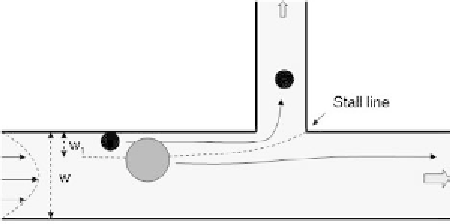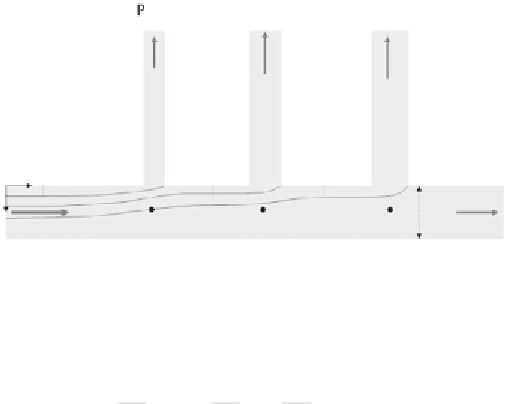Biomedical Engineering Reference
In-Depth Information
Figure 6.73
Flow in a branched network.
where
Q
1
is the flow rate in the secondary channel. Using (6.122) and (6.123)
3
2
*
w
w
Q
æ
ö
æ
ö
1
1
1
(6.124)
-
+
=
2
3
0
ç
÷
ç
÷
è
ø
è
ø
w
w
Q
Assuming that the flow rate distribution in the network is known—or has been
calculated by the network theory of Chapter 2—(6.124) can be solved to produce
the threshold width
w
1
. Wall focused particles with a diameter
D
< 2
w
1
will turn
into the side channel.
6.5.6.2 Zweifach-Fung Bifurcation Law for Blood Flow
It has been experimentally observed that, at a bifurcation, blood cells have a ten-
dency to travel into the daughter vessel that has the higher flow rate, leaving very
few cells flowing into the lower flow rate vessel [41, 42]. The critical flow rate ratio
between the daughter vessels for this cell separation is approximately 2.5:1 when
the cell-to-vessel diameter ratio is of the order of 1. The first reason for this ap-
portioning is that cells are drawn into the higher flow rate vessel because they are
subjected to a higher-pressure gradient—due to the relative velocity difference, as
in the case of the lift. The second reason is the torque on the cell/particle associated
with the difference of relative flow velocity (Figure 6.75).
This property, linked to the Farhaeus effect, has been used to design plasma
extraction microsystems [43-45]. The principle is illustrated in Figure 6.76.
Figure 6.74
Trajectories of spherical particles at a bifurcation.












































